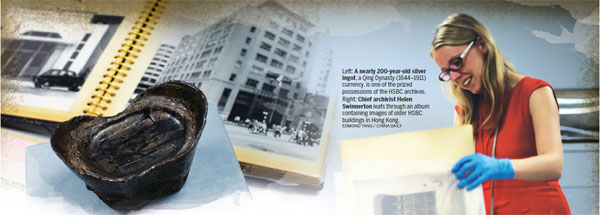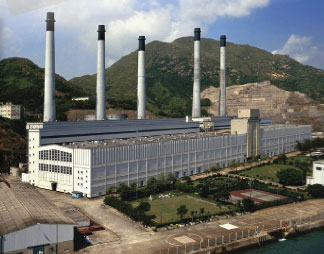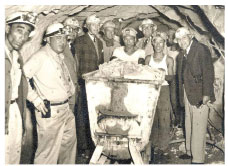Company un-limited
Updated: 2015-09-15 08:09
By Chitralekha Basu(HK Edition)
|
|||||||
As more people turn to company archives to satisfy their research needs, Chitralekha Basu asks if these might be replacing more conventional information sources.
'Go ahead, lift it," says Helen Swinnerton. She is holding a cardboard box containing a boat-shaped silver ingot, patina-ed over from close to 200 years of exposure to oxidization. The boat-shaped Qing Dynasty (1644-1911) currency, which could fit in snugly between the palms of a grown man, is heavier than it looks. My hands buckle under the suddenness of the weight (approximately 2 kg, I'm told later).
The silver ingot is only one of the priceless items held in the fire-protected vault in Tower 3 of HSBC Centre in Kowloon. Stored in acid-free boxes, held together by brass pins to prevent rusting, are minutes of company meetings, ledgers and annual reports from the late 1800s to the 1950s. The earliest documented minutes, dated Aug 6, 1864, contains a record of the historic moment in which large mercantile houses of British, American, Indian and German origins - Peninsular & Oriental Steam Navigation Co, PF Cama & Co, P&A Camajee & Co, Douglas Lapraik, Gilman & Co - came together to form a provisional committee. This was the genesis of Hong Kong and Shanghai Bank, founded subsequently on March 3, 1865. Although the idea was "to fill the gap in finance trade between Asia and the West", it wasn't until 1971 that the first Chinese member, Yue-kong Pao, came on board, notes Swinnerton.
Swinnerton has been in charge of the bank's archives in Hong Kong since 2004. The custodian of an enormous number of letters, photographs, cartoons, films, advertising material, banknotes, architectural drawings and close to 400 audio-taped interviews with bank staff, she goes about her daily job of identifying, sourcing and filing away archive-worthy material with her able hands, meticulously wrapped in latex gloves.
Getting to handle history on a daily basis, must be exciting. Swinnerton seems to be re-living the moment of Hong Kong's post-war regeneration as she points to a letter by Arthur Morse placing an order to set up a power plant in Kowloon following Hong Kong's liberation from Japanese occupation in 1945. Morse headed the bank from 1943 to 1953. He was described by Hong Kong governor, Sir Alexander Grantham, as "The man who since liberation has probably done more for Hong Kong than any other single individual", notes Swinnerton, admiringly.
What really stimulates her though, is seeing the archives serve as a public utility. "I particularly enjoy enabling archives to be used and appreciated," says Swinnerton. "It's a very rewarding experience, for example, helping families whose ancestors have worked for HSBC, to piece together their own histories."
HSBC archives in Hong Kong, begun sometime in the mid-1970s, doubled as a resource pool for "economic and social historians, university and college students, genealogists, architectural researchers, local historians and television and film companies" almost from the outset, informs Swinnerton. That the bank was keen to preserve its own history is evident in the scrupulous attention to documentation. The earliest banknotes from 19th century with images of classical Greek caryatids engraved in the border were stamped "Sample" and filed away in albums. Happily, the bank's governors have traditionally opened their doors to researchers, writers and historians interested in Hong Kong's social and economic history - particularly the story of its growth as a trade hub in the 19th century and the revival following the war years in the 20th.
Public resource
As more Hong Kong-based enterprises are eager to hold on to the ledger books and sepia-tinted photographs from their past, most also are warming up to the idea of sharing such resources. Often begun as a cache of internal documentation, company archives seem to have assumed a life of their own along the way, serving a far wider spectrum of people and interests than was originally intended.
Michael Kadoorie started Hong Kong Heritage Project (HKHP) in 2007 with the idea of reconstructing and conserving the history of family-owned businesses - Hong Kong and Shanghai Hotels and China Light and Power Company. "The project was begun as a business archive," says Fanny Iu, HKHP's executive director. "We decided to put all the documents together in a dedicated facility. And then we realized we could probably do much more with the material. It took us two years to catalogue everything, open the digital archive to the public, and launch a website to help people know where to look."

One of the beneficiaries of HKHP's endeavor to serve as an information base for the public is Hulu Culture, a non-governmental organization interested in ethno-cultural studies of different neighborhoods in Hong Kong. Simon Go, chairperson of Hulu, recalls collaborating with HKHP to showcase the local culture of Hung Hom and Ho Man Tin.
"Apart from the photos, maps and materials from the HKHP archive, HKHP also produced a tailor-made article for us, discussing the development of Hung Hom and Ho Man Tin," says Go. "We have included it on the official website for the exhibition, and adapted the text in the form of exhibition panels and a booklet, allowing the public to have access to the article through different platforms".
"Also it makes economic sense," he adds. "If you approached the HK Information Centre, a single photo would cost HK$1,000. Since we are an NGO, working on a limited budget it helps that HKHP shares photo and text with us free of charge. I think they are playing a huge social role for the Hong Kong community by promoting local culture."
HKHP's current resources include 470 interviews of figures related to Hong Kong's industry, captured on film, 150 linear meters of paper records, 8,000 business-related photographs, over 1,000 maps of old Hong Kong, besides images showing floor plans, factory site blue prints. HKHP archives are a go-to destination for researchers studying Hong Kong's Jewish connections.
"We have the largest collection of oral history recordings in Hong Kong," says Iu. It covers quite a range, from Hong Kong's oldest stockbroker, to factory girls and miners, to former Hong Kong governor Sir David Wilson and Andrew Ostroumouff - the general manager of The Repulse Bay and The Peninsula hotels in mid-20th century. It's an extraordinarily rich pool of resources, from which government departments and government-run museums often borrow, as they recently did for the Factory Hong Kong show at HK Heritage Discovery Centre. "We are not in competition with government-run projects to collect oral history. We try to complement each other," adds Iu.
Military history expert and Hong Kong Baptist University professor Kwong Chi-man used HKHP archives to consult papers of Colonel Lindsay Ride, the commander of the British Army Aid Group from 1942 to 1945. These include "intelligence reports about Hong Kong and South China as well as other related primary and secondary sources instrumental to our understanding of that complicated period" which Kwong says would be difficult to find elsewhere.
Are company archives replacing, or at any rate, complementing conventional data sources such as university archives, libraries and museums, given more people are turning to these to address their research-related needs or pursue matters of personal interest?
Stacy Lee, director of archives at the University of Hong Kong, is skeptical. "Company archives which are the accumulated records of a business as opposed to those of a government, university, church or some other organization, will never take the place of those other types of archives," she asserts.
"One certainly has to visit both government and company archives if one wants to understand the development of banking in Hong Kong, otherwise one can only tell a one-sided story," says Kwong. And the importance of libraries cannot be under-estimated, given they "offer not only primary sources but also previous studies that allow us to have a more comprehensive understanding of the topics".
"Company archives, however," Kwong adds, "offer a unique corporate or business perspective, when we try to understand the history of Hong Kong as well as the Chinese mainland, as many historical companies in Hong Kong also have a long history of operating on the mainland."
Serendipitous finds
When British Columbia-based author Sharon Oddie Brown began digging her family history, she didn't have a clue that much of her research will be centered on the HSBC archives in Hong Kong, throwing light on her ancestors' involvement in the banking history of both Hong Kong and the Chinese mainland.
As a child, Brown was drawn to a family heirloom - a gorgeous silver bowl with intricate chrysanthemum patterns. She was told it was a Japanese emperor's gift to one of her forebears. Tracing the bowl's provenance led to a journey across continents. Brown discovered many of her antecedents from Northern Ireland had served on HSBC's staff. The list included the illustrious Sir Thomas Jackson, who headed HSBC's Hong Kong operations from 1876 to 1893 and helped the bank reach unprecedented heights as a market leader in Asia.
The curiosity to find out more about "how the ethics and values of young men who lived through the Irish famine, as sons of tenant farmers from South Armagh, came to shape the early banking history of Hong Kong" was not without serendipitous moments. Early in 2013, HSBC's Hong Kong archive staff dug out an exquisite scroll for Brown to examine. The scroll was presented to Jackson by the leading Chinese merchants of Hong Kong as a farewell gift in 1893. Brown was overwhelmed by the striking artwork, the still-lustrous colors in the embroidered phoenix and herons, as well as the beauty of friendship across cultures encapsulated in that historic moment.
"I wish more businesses handled their archives like HSBC does," says Brown. "It is impossible to learn much about business history when private archives are not maintained."
But then a company obviously plays up its achievements and skims over the low points in its documents. Is there a risk of some of that subjectivity rubbing off on the researcher accessing those files?
Brown disagrees. "There is no risk - at least not in how HSBC is handling it," she says. "They don't edit their holdings in order to whitewash their history."
While historians have traditionally used company archives, Kwong notes there is a growing trend of the public seeking access to these as well. "It is because the scope of academic and public interest in Hong Kong and Chinese history is very wide."
Researchers are looking beyond more conventional sources of information too, he adds. "Nowadays they consult a wide range of sources, from government documents to private correspondence."
Where company archives score above the rest is in "offering unique insights and interesting examples of case-studies", says Kwong.
Contact the writer at basu@chinadailyhk.com
|
Left: A nearly 200-year-old silver ingot, a Qing Dynasty (1644-1911) currency, is one of the prized possessions of the HSBC archives. Right: Chief archivist Helen Swinnerton leafs through an album containing images of older HSBC buildings in Hong Kong. Edmond Tang / China Daily |
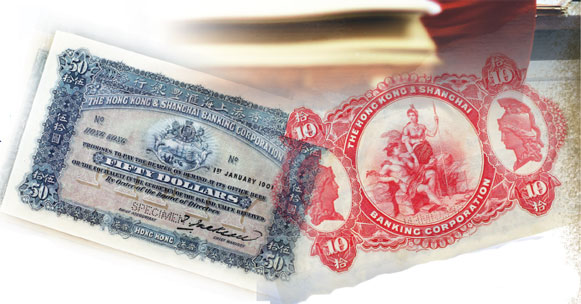
|
|
|
|
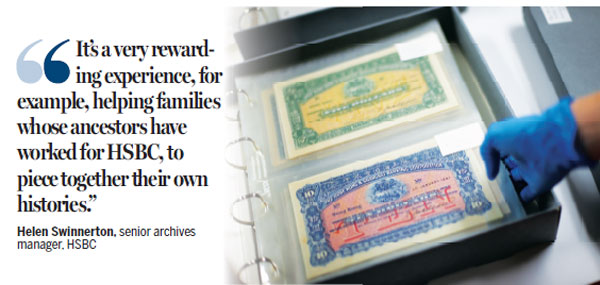
(HK Edition 09/15/2015 page10)
